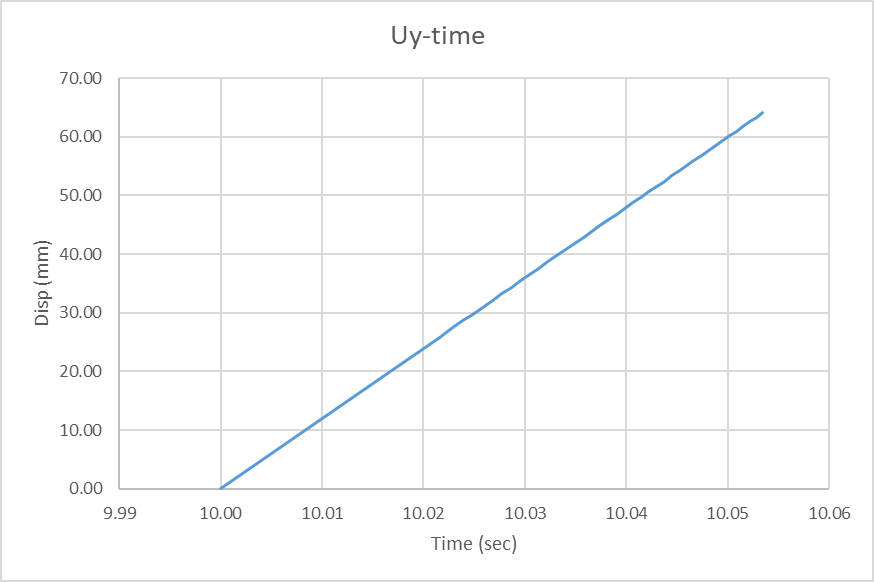Ansys Learning Forum › Forums › Discuss Simulation › LS Dyna › Initial Velocity Generation › Reply To: Initial Velocity Generation
Dear Pedram,
I will definitely take advantage of your kind offer.
But first I would like to make sure that my assumptions are correct.
So:
1. I could not learn to regulate the recording of calculation results at the initial stage of using an explicit solver.
For some unknown reason, the program ignores my instructions and writes the calculation results “arbitrarily” – immediately after switching the solver type – in this model – about 0.02 seconds.
After 0.02 seconds, the results are recorded with a step “close” to the required step, but still not exactly to my requirements specified in the curve.
- I am interested in the calculation results at the initial moment of time – at the moment of impact of the load.
2. Since I couldn’t solve the 1st problem, I tried to use the command:
Velocity_Generation_Start_Time
Where, according to the documentation, you can set a “delay” in time for the initial velocity applied to the “rigid” body.
However, ls-dyna ignores any specified delay values and the initial velocity is activated at the moment of switching from the implicit to the explicit solver.
3. Taking into account my unsuccessful attempts 1 and 2.
I decided to achieve the required delay in the time of application of the initial velocity by moving the falling load a distance that I calculated from the specified initial velocity of 1000 mm per second.
However, from the analysis of the solution I found that the initial velocity of the load is not 1000 mm per second, but 2567 mm per second!
0.00805664 sec is the time of motion of the rigid body
20.68639946 mm is the distance the rigid body has moved
2567.62117458 mm/sec is the constant speed of motion
If someone wants to get acquainted with my model – see the link below
https://drive.google.com/file/d/1jf3XCB1v87ImHqMO-PfN6SXNVcTPGAUT/view?usp=sharing
I will be very grateful for any advice – since in this case I have a stalemate.
———————————-
I tried to solve this problem with other data – trying to understand possible patterns, and I was very surprised, since the initial speed given was different each time?!
Below is another example of the solution
| time | Uy |
| 10.0000000 | 0.0000000 |
| 10.0168285 | 20.1738129 |
| 10.0215492 | 25.8324966 |
| 10.0228729 | 27.4195175 |
| 10.0238628 | 28.6061802 |
| 10.0248413 | 29.7792721 |
| 10.0258083 | 30.9385910 |
| 10.0267649 | 32.0844803 |
| 10.0277100 | 33.2173271 |
| 10.0286436 | 34.3369370 |
| 10.0295668 | 35.4437866 |
| 10.0304794 | 36.5377007 |
| 10.0313816 | 37.6189613 |
| 10.0322733 | 38.6876526 |
| 10.0331545 | 39.7442780 |
| 10.0340252 | 40.7885284 |
| 10.0348864 | 41.8205681 |
| 10.0357380 | 42.8409538 |
| 10.0365791 | 43.8493919 |
| 10.0374107 | 44.8462029 |
| 10.0382328 | 45.8315926 |
| 10.0390453 | 46.8054848 |
| 10.0398483 | 47.7680931 |
| 10.0406418 | 48.7197609 |
| 10.0414267 | 49.6601524 |
| 10.0422020 | 50.5898819 |
| 10.0429688 | 51.5088005 |
| 10.0437260 | 52.4171677 |
| 10.0444756 | 53.3149796 |
| 10.0452156 | 54.2024994 |
| 10.0459471 | 55.0797882 |
| 10.0466709 | 55.9469223 |
| 10.0473852 | 56.8037834 |
| 10.0480919 | 57.6509781 |
| 10.0487909 | 58.4884300 |
| 10.0494814 | 59.3161201 |
| 10.0501642 | 60.1341667 |
| 10.0508385 | 60.9428711 |
| 10.0515051 | 61.7423515 |
| 10.0521641 | 62.5323830 |
| 10.0528164 | 63.3134384 |
| 10.0534601 | 64.0852509 |
| Dt | 0.0534601 |
| D_Uy | 64.0852509 |
| speed | 1198.7487 |
For the last solution, the initial speed was specified -2800 mm per second,
but in reality – according to the calculation – the speed was 1198 mm per second



